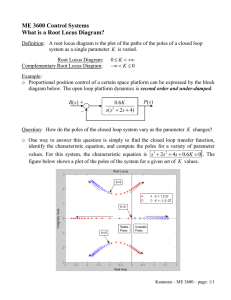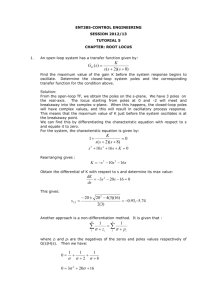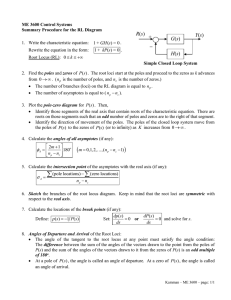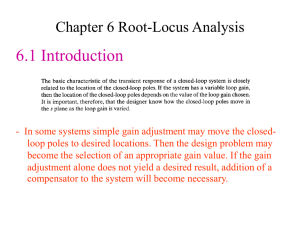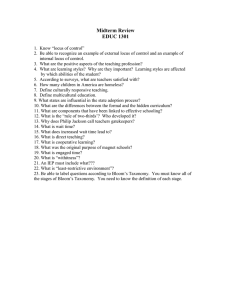Root Locus
advertisement
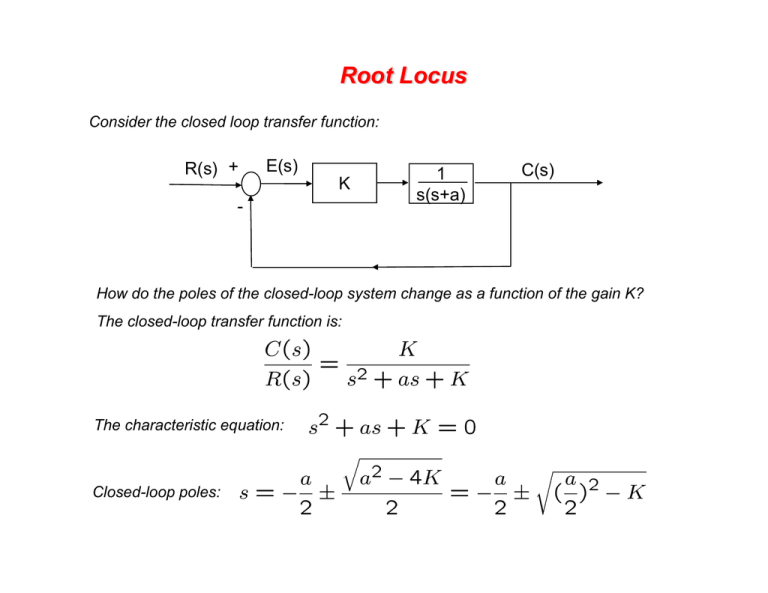
Root Locus Consider the closed loop transfer function: R(s) + E(s) K - 1 s(s+a) C(s) How do the poles of the closed-loop system change as a function of the gain K? The closed-loop transfer function is: The characteristic equation: Closed-loop poles: Root Locus When the gain is 0, the closed loop poles are the openloop poles Roots are real and distinct and for a positive a, in the left half of the complex plane. Two coincident poles (Critically damped response) Roots are complex conjugate with a real part of –a/2. Im K=0 X K=0 X Re 0 Root Locus The locus of the roots of the closed loop system as a function of a system parameter, as it is varied from 0 to infinity results in the moniker, Root-Locus. The root-locus permits determination of the closed-loop poles given the open-loop poles and zeros of the system. For the system: R(s) + C(s) E(s) G(s) - H(s) the closed loop transfer function is: The characteristic equation: Root Locus when solved results in the poles of the closed-loop system. The characteristic equation can be written as: Since G(s)H(s) is a complex quantity, the equation can be rewritten as: Angle criterion: Magnitude criterion: The values of s which satisfy the magnitude and angle criterion lie on the root locus. Solving the angle criterion alone results in the root-locus. The magnitude criterion locates the closed loop poles on the locus. Root Locus Often the open-loop transfer function G(s)H(s) involved a gain parameter K, resulting in the characteristic equation: Then the root-loci are the loci of the closed loop poles as K is varied from 0 to infinity. To sketch the root-loci, we require the poles and zeros of the open-loop system. Now, the angle and magnitude criterion can be schematically represented as, for the system: Root Locus Im Im s A2 θ2 θ2 X X -p2 A1 A4 B1 θ4 X -p4 s A3 -p2 A2 A4 θ1 φ1 X -z1 -p1 Re X -p4 φ1 θ4 A1 B1 X -z1 -p1 A3 θ3 X -p3 θ1 θ3 X -p3 Re Root Locus (Example) Consider the system: R(s) + E(s) - The open loop poles and zeros are: Determine root locus on the real axis: Select a test point on the positive real axis, which indicates that the angle criterion is not satisfied. Consider a test point between 0 and -1, then The angle criterion: indicates that the angle criterion is satisfied. C(s) Root Locus (Example) Consider a test point between -1 and -2, then The angle criterion: indicates that the angle criterion is not satisfied. Consider a test point between -2 and -infinity, then The angle criterion: indicates that the angle criterion is satisfied. Thus, a point on the real axis lies on a locus if number of open-loop poles plus zeros on the real axis to the right of this point are odd. Root Locus (Example) Asymptotes of the root-loci as s tends to infinity can be determined as follows: Select a test point far from the origin: and the angle criterion is: or, the angle of the asymptotes are: For this example, they are 60o, -60o, -180o. To draw the asymptotes, we must find the point where they intersect the real-axis. Since, the transfer function for a test point s far from the origin permits us to approximate the transfer function as: Root Locus (Example) The angle criterion for the approximated system is: Substituting , we have Taking the tangent of both sides, we have: which can be written as: Root Locus (Example) The three equations result is three straight lines shown below, which are the asymptotes, which meet at the point s=-1. Thus, the abscissa of the intersection of the asymptotes and the real-axis is determined by setting the denominator of the approximated transfer function to zero and solving for s. Im -1 Re Root Locus (Example) The root loci starting from 0 and -1, break away from the real axis as K is increased. The breakaway point corresponds to a point in the s-plane where multiple roots of the characteristic equation occur. Representing the characteristic equation as: We know that f(s) has multiple roots at s = s1, if Which when substituted into Equation 1, gives us: Root Locus (Example) Consider the equation: which can be rewritten as: The derivative of K with respect to s gives: Which when set to zero gives the same constraint as before: Therefore, the breakaway point can be determined by setting: Root Locus (Example) For the current example, we have: The derivative of K with respect to s gives: or Since the breakaway point must lie between 0 and -1, s = -0.4226 corresponds to the actual breakaway point and the corresponding gain is: The gain corresponding to the point s = -1.5774 is: Which belongs to the complementary root-locus. Root Locus (Example) Locations where the Root-loci crosses the imaginary axis can be determined by substituting s = jω in the characteristic equation as solving for K and s. For the current example, we have or Equating the real and imaginary parts to zero, we have which results in the solutions: Thus, the root locus cross the imaginary axis at Root Locus (Example) Consider the system with an open-loop transfer function: which has open loop poles at: and a zero at From the rule about existence of root-loci on the real axis, it is clear that to the left of the point s=-2, the entire real axis is part of the root-loci. Since root-loci start at open-loop poles and end at open-loop zeros, we know that the two root-loci which start at the complex open loop poles should break in on the real axis and one of the root-loci should move towards s = -2, and the other towards How does the root locus depart from ? Root Locus (Example) Consider a test point s in the vicinity of the complex open-loop pole p1: Im s θ1 X -p1 φ1 Re -z1 θ2 X -p2 The angular contribution of the pole p2 and the zero z1 to the test point s can be considered to be the same as the angle made by the lines connecting the pole p2 and zero z1 to the pole p1 (if the test point is close to p1). Then, the angle of departure t1 is given by the angle criterion: Root Locus (Example) Determine break-in point of the root-loci: Root Locus (sketching rules) Rule 1: Root locus is symmetric about the real axis • roots of characteristic equations are either real or complex conjugates •Can draw upper half plane only, although typically full s-plane loci are sketched Rule 2: Each branch of the root locus originates at the open-loop pole with k=0, and terminates either at an open-loop zero or at infinity as k tends to infinity. Characteristic Equation: When k=0, poles at: which are open-loop poles Rewrite Characteristic Equation: When k-> infinity, poles at: which are open-loop zeros -m branches of the root loci terminate at open-loop zeros - remaining (n-m) branches go to infinity along asymptotes as k-> infinity Root Locus (sketching rules) Rule 3: A point on the real axis lies on a locus if number of open-loop poles plus zeros on the real axis to the right of this point are odd. Rule 4: The (n-m) branches of the root loci which tend to infinity do so along straight line asymptotes whose angles are: Rule 5: The asymptotes cross the real axis at a point given by: Root Locus (sketching rules) Rule 6: Break points (points at which multiple roots of the characteristic equation occur) of root locus are solutions of dk/ds = 0. Rule 7: The angle of departure from an open-loop pole is given by: where φ is the net angle contribution at the pole of all other open-loop poles and zeros. Similarly, the angle of arrival at an open-loop zero is given by: where φ is the net angle contribution at the pole of all other open-loop poles and zeros. Angle of departure from real open-loop pole or angle of arrival at real open-loop zero is always 0 or π. Rule 8: The points at which branches cross the imaginary axis can be determined by letting s=jω in the characteristic equation. Control Design using Root Locus Effect of addition of poles: Control Design using Root Locus Effect of addition of zeros: Control Design using Root Locus Consider the open-loop system with a transfer function: The root locus of this system is: The close loop transfer function is: with closed loop poles of: It is desired to modify the closed-loop poles so that the closed loop poles have a natural frequency of 4 rad/sec and a damping ratio of 0.5, or which does not lie on the original root-locus. We need a compensator to move the poles. Control Design using Root Locus Angle criterion requires: Since the angle is 30 less than what it should be, add 30 degree via a zero, or a PD controller k(s+z). The location of the zero ‘z’ is selected to satisfy the angle criterion. Control Design using Root Locus Thus, the zero is located at: The PD controller is k(s+8). The open loop transfer function is: The magnitude criterion is used to determine k:

